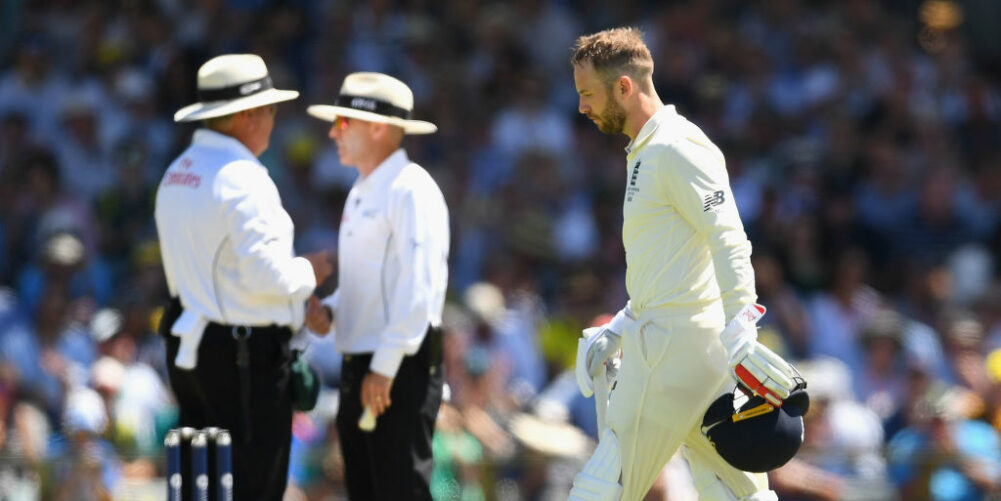(Photo: Getty Images)
By Derek Pringle
There are those, most within England’s dressing-room, who feel Mark Stoneman was more than a little hard done by after he was given out caught behind off Mitchell Starc in England’s first innings.
Not only was the ball, a fast rearing delivery that ended up nose high in a millisecond, an absolute snorter, but the catch by Tim Paine, one handed and above his head, was brilliant and as balletic as cricket gets.
Now for the controversial bit. Umpire Marais Erasmus did not feel the left-handed Stoneman got a glove to the ball as he strove to ride the bounce. Stoneman, in the manner of most cricketers these days, stood his ground.
For readers of body language there were clues. Most batsmen would look at the umpire in such circumstances to see what decision he might make. Yet Stoneman pointedly avoided eye-contact with Erasmus, which suggested a man trying to get away with one. Let’s put it this way – I doubt he would have reviewed the decision had Erasmus raised his finger.
This is where things get a bit blurry, morally. With bowler and close fielders in no doubt over the dismissal, Erasmus’s not out decision was reviewed, with third umpire Aleem Dar the man in the hot seat.
TV replays shown to Dar, as well as Hotspot, did not show any evidence at all of ball making contact with Stoneman’s gloves. This was compounded by the fact that he’d taken his bottom hand off the bat – the current Laws stating that a batsman cannot be out if the ball has come off a glove not in contact with the bat.
This has always struck me as a ridiculous ‘get-out’ clause (and lest we forget, one that would have cost England their famous two-run victory against Australia at Edgbaston in 2005), and should be changed forthwith.
The Snickometer was then run from side-on and there was a spike as the ball passed the glove holding the bat handle, it being obvious from the ball’s trajectory that it had not brushed the bottom hand.
The burden of proof insisted on by the International Cricket Council to overturn the on-field umpire’s decision is that there must be ‘conclusive’ evidence to the contrary. On this occasion, one ticked box out of three is far from conclusive in most people’s book but Dar, perhaps on instinct gained from standing in over 100 Test matches, asked Erasmus to overturn his decision.
This got many exercised, Joe Root and Paul Collingwood among them. Both poked their heads out of the England dressing-room to tell Stoneman to stay on the pitch, presumably in the hope that the overturned decision might itself be overturned. But Erasmus waved him off.
With regard to protocol, and on the evidence shown to the third umpire, Stoneman was hard done by. But another TV replay, shown a few minutes after he had departed, showed Dar to be correct in his judgement.
In the end, the right decision was made albeit via the wrong process. Yet, this is where the DRS process has become confused.
As a bowler, I would want the right decision to be made however complex or finely wrought it might be. Yet ICC’s persistence in protecting their umpire’s pride, especially in regard to lbw judgements with ‘umpire’s call’, insists that the system is there only to prevent howlers from umpires, not the honest mistake. That is feeble. If the technology is there, use it to ensure accuracy and not to shore up error.

It was a brute of a ball from Starc but Stoneman, who once again passed fifty, might have avoided both the controversy and the dismissal if he possessed a foolproof way of avoiding the well-directed short ball.
Stoneman uses minimal footwork when he bats against pace bowlers.
But while keeping still has its benefits, it can leave a batsman as something of a target to quick bowlers, especially on a pitch offering them plenty of inspiration to inflict some pain as the WACA usually does.
He also doesn’t appear to hook or sway, preferring to play anything below chin high with a defensive bat. That means you have to get into line, a painful experience if you make the slightest misjudgment as he did when Josh Hazlewood crusted him in the 32nd over.
It was a nasty one right on the side of the grille and one which visibly shook Stoneman. Thereafter, the Aussies gave him a good working over until Starc produced the ball with his name on it.
The benefits of possessing good methods of avoiding the bouncer became apparent soon after Stoneman’s departure. Dawid Malan and Jonny Bairstow both adopted the sway with Malan selectively taking the odd short ball on with the pull and hook.
When you can avoid the short ball without drama and then, as Malan began to do, score runs off it, the bowlers have to resort to Plan B. Of course both batsmen benefitted from facing an older more benign ball, and from facing Nathan Lyon without any turn, but both came through torrid beginnings to their innings so their treasure was hard won.
Stoneman has impressed many with his calm demeanour and his organised approach to batting. If he can sort out a workable method against the short ball, a bountiful future awaits. Bairstow had the same problem and managed to overcome it. Perhaps they should have a chat.















